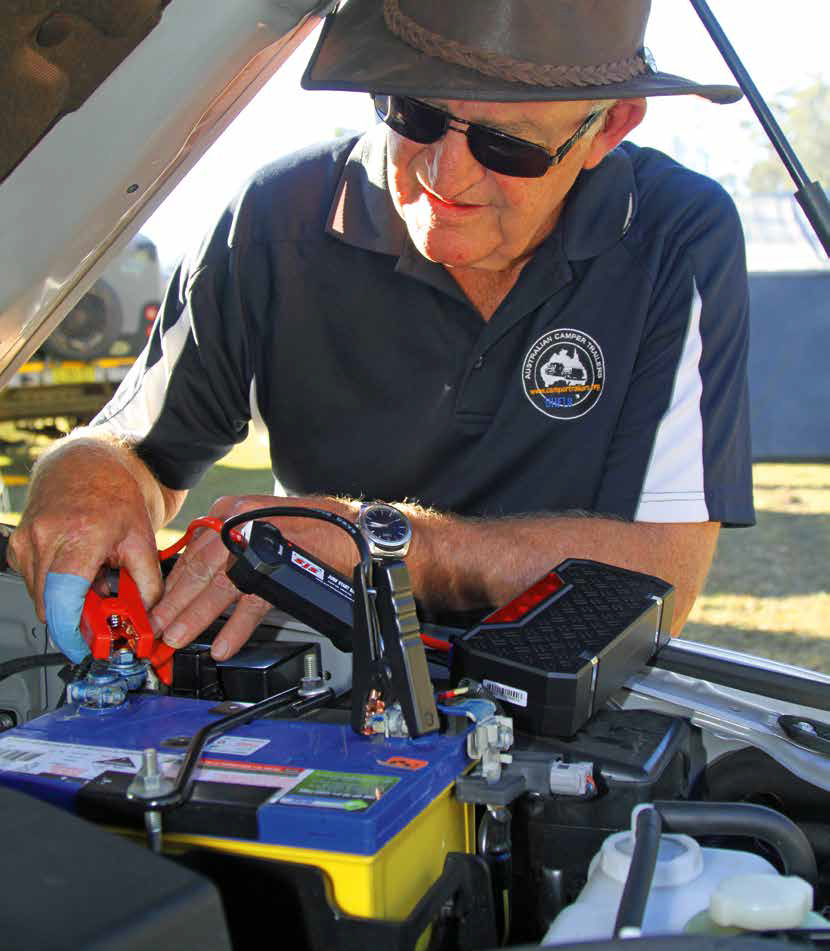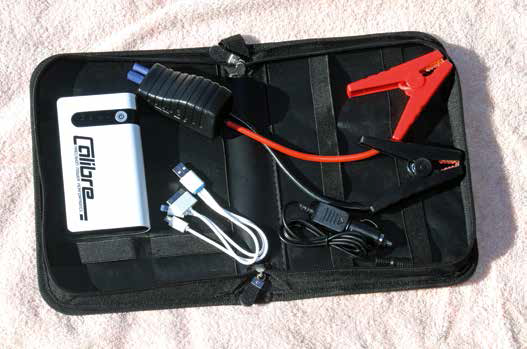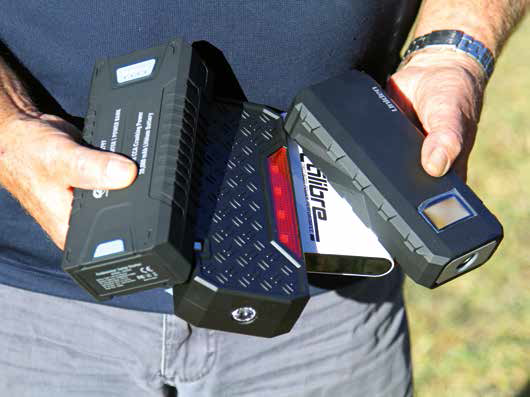
When you’re frequently on the road, a little doubt niggles every time you feed your key into the ignition: will there be that reassuring spin followed by the engine bursting into happy life? Fortunately, those doubts usually evaporate and without thinking we accept the systems operating our vehicles will serve us well. But every now and then they fail to the sad, slow turn of the crankshaft or worse still, to a ‘click, click’ sound.
THE BATTERY HAS CARKED IT
In the past, a jump start required a willing traveller able to get their battery close enough to yours for the jumper leads to reach, or one those handy, if hefty, jump starters, with leads connected to wet cell battery encased in a poly box. But in recent times, small lithium polymer battery packs are now claiming to achieve the same thing.
The sales hype quotes figures in the many thousands of milliamps (mA) and we are assured one will fit in our shirt pocket or handbag. But can they really do the job? Well, the short answer is mostly yes, but sometimes, no.
A unit’s ability to start a vehicle depends on its stored power capacity, the type of vehicle, and the degree of discharge in the vehicle’s battery.
IGNORE THE MILLIAMPS
A milliamp is just one thousandth of an amp, and they look better than amps, because there are more of them. It’s best to ignore the quoted figures for amps and cold cranking amps, the usual measure for a battery’s ability to turn over an engine. Manufacturers may quote a peak amperage at the jumper unit’s terminal, which lasts a nanosecond or so, and is well over what’s sustained at the battery clamps for even a few seconds. A watthour (Wh) rating is more reliable, where one watt-hour equals the consumption of a watt of energy for one hour, as it must meet a global standard for transport purposes.
WHY GO LITHIUM?
Although older wet-cell starters are effective back-ups for your batteries, technology has improved the functionality of our battery-powered items. Lithium-based batteries sustain their voltage output from fully-charged to almost dead flat, are quicker to charge, hold their charge longer, are generally more tolerant of misuse and are much lighter and smaller than battery with other chemistries.
All lithium battery packs should have over-discharge protection. Generally, the power pack will turn off around 8.5V to 9.5V. In terms of jump starters, this means considerable savings in size and weight - with many units weighing less than a kilogram. Some can be used as torches, have USB ports for charging phones or laptops, or connections for tyre compressors. In referring to “lithium polymer” (often shortened to LiPo) we are more correctly talking about lithium-ion technology that uses a high solid (gel) polymer electrolyte instead of the more commonly used liquid electrolyte.
There are no Australian standards for these products but many power packs cells are UL-rated, which is a stringent USA standard.
CAPACITY
Engine size greatly impacts in the demands made on a jump starter, simply because of the number and size of components that must be turned over. Generally, petrol-fuelled vehicles will require minimum output peak current of:
Diesels, which have much higher internal compression ratios, will require minimum capacities of:
These figures can be regarded as minimums, so aim for something higher if you can afford it to ensure you have a margin of safety.

From far left: The Endeavour Tools ET6797 Jump Starter
OPERATING EXTREMES
Many jump starters will operate in any ambient temperature you’re likely to experience in Australia but some won’t, so do your research, and read all the instructions before use. The temperature in a vehicle boot can reach 90 degrees Celsius or more on a hot day, and that will be above the operating maximum for any jump starter. At lower temperatures (around freezing) the performance of any jump starter will be greatly impaired. Extremely low temperatures will impose an added load on any jump starter attempting to turn over an engine by slowing the chemical reactions which produce the current flow.
Do your research and read the documentation on your proposed unit to ensure you are within operating parameters.
CABLING
Look for a unit that has well-shielded sturdy battery clamps: the harder they are to put on the better they will grip the battery terminals and do their job of making a good electrical connection. The larger the gauge of the cables the less resistance to current flow to the vehicle’s battery and so, the more efficient it is likely to be. You also don’t want excessively long cables, to minimise resistance, but not so short that you can’t comfortably connect the terminals and have the jump starter battery securely seated on surrounding structure (don’t sit it on the battery).
START-ELING CLAIMS
Be wary of claims regarding the number of ‘starts’ that can be made from a jump starter pack. A completely flat battery in a car will draw much more from the jump starter battery than one that is down only enough to just prevent the car’s starter from cranking over the engine. The number of starts on one charge will depend on the state of the vehicle’s battery.
KEEP IT CHARGED
One of the biggest problems that is likely to arise in the use of a battery jump starter is that it may not be fully charged when you need it. Despite its lithium technology it will slowly self discharge, so you need to a have a disciplined approach to keeping it topped up from the mains supply at home - put it on your checklist of pre-trip things to do. Read your unit’s paperwork, as some recommend charging annually, others every three months. If uncertain, a regime close to the latter will help sustain the battery and won’t create any problems. These are complex and sometimes delicate devices, as illustrated by some of the warranties, which are as short as six months.
SAFETY
LiPo batteries adhere to stringently-enforced aircraft transport regulations for a reason, so be sure to take care. So always use the dedicated charging unit to maintain your LiPo jumpstarter, or any other appliance with a rechargeable battery for that matter. Labelling and checking your chargers before plugging them in will avoid this issue.
Overcharging, excessive discharging, over-temperature, short circuit, crush or penetration issues can cause structural failure, leaking electrolyte and fire. That said, the appropriate design of ancillary equipment minimises these risks, but as with all lithiumpolymer battery-powered items, you are dealing with something with high-energy density - which you shouldn’t be casual about.

Power Bank and the units selected to test
TAKING TO THE AIR
For air transport, 160Wh is the maximum battery capacity permitted and it must be carried on as hand luggage and be in its enclosed carry case with the terminals not exposed. Always check an airline’s battery policy before fronting up to the airport, as it can change regularly depending on any recent happenings around the world.

Category: Technology
Written: Fri 01 Dec 2017
Printed: December, 2017
Published By:
CRUNCHING THE NUMBERS
All lithium cobalt polymer (lithium ion common name) battery cells are 3.7V each. There are usually three cells in a jump start power pack connected in series (3S), which gives a nominal voltage of 11.1 volts. Fully charged they are usually 12.5V. To determine the capacity in a lithium battery power pack, e.g. 120Whrs, divide by 3.7V = 32,430mAh (32.43Ahr), or 3.7V x 32.43 = 120Whrs. This is the formula that is used worldwide for all shipping and airfreight. To convert watt-hours to amps divide by volts. In other words a 120Wh jump starter pack will produce a notional 10 amps (120 divided by 12) in a 12V system. Overstating of battery capacity in these products is quite common so be aware. Battery capacity provides power. The larger the capacity the more jump start power the unit should have. Like any type of battery the price you pay is related to the claimed capacity of the battery pack. A very rough guide as to the maximum peak amps at the jumper clamps you should expect when jump starting a vehicle is to multiply the claimed capacity in watt hours by a factor of 10. For example, a claimed 60Whrs capacity x 10 should produce a maximum peak current at the clamps of 600A. The maximum cell power claims in the thousands of amps can be a little confusing. MCP is the claimed absolute power output of the battery cell itself for a period of less than 0.5 seconds. As it takes longer than 0.5 seconds to jump start a car one would assume that MCP is a marketing ploy, but not quite so. Generally the higher MCP claim will give you a higher claimed maximum peak current and maximum start current. Maximum peak clamp current is the current required to initially turn the engine over for around three seconds until the flywheel and inertia of all the moving parts in the engine takes over.
We are indebted to Ross Loudon, Managing and Technical Director of Smart Jump Starters for his assistance with this.